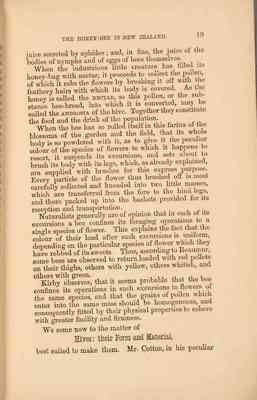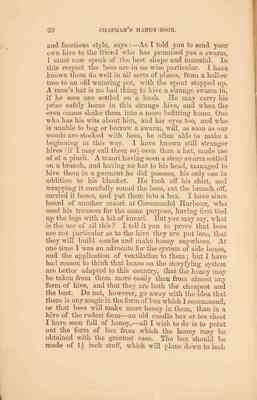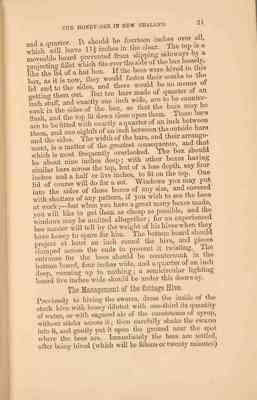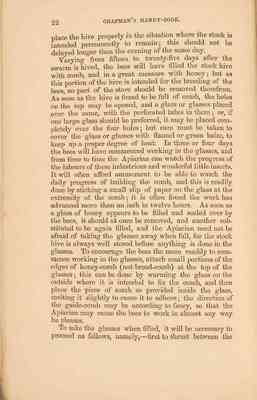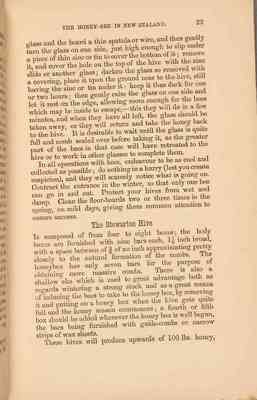Pages
THE HONEY-BEE IN NEW ZEALAND 19
juice secreted by aphides; and, in fine, the juice of the bodies of nymphs and of eggs of bees themselves. When the industrious little creature has filled its honey-bag with nectar, it proceeds to collect the pollen, of which it robs the flowers by brushing it off with the feathery hairs with which its body is covered. As the honey is called the NECTAR, so this pollen, or the substance bee-bread, into which it is converted, may be called the AMBROSIA of the hive. Together they constitute the food and the drink of the population. When the bee has so rolled itself in this farina of the blossoms of the garden and the field, that its whole body is so powdered with it, as to give it the peculiar colour of the species of flowers to which it happens to resort, it suspends its excursions, and sets about to brush its body with its legs, which, as already explained, are supplied with brushes for this express purpose. Every particle of the flower thus brushed off is most carefully collected and kneaded into two little masses, which are transferred from the fore to the hind legs, and there packed up into the baskets provided for its reception and transportation. Naturalists are generally of opinion that in each of its excursions a bee confines its foraging operations to a single species of flower. This explains the fact that the colour of their load after such excursions is uniform, depending o the particular species of flower which they have robbed of its sweets. Thus, according to Reamur, some bees are observed to return loaded with red pellets on their thighs, others with yellow, others with whitish, and others with green. Kirby observes, that it seems probable that the bee confines its operations in such excursions to flowers of the same species, and that the grains of pollen which enter into the same mass should be homogenous, and consequently fitted by their physical properties to cohere with greater facility and firmness. We come now to the matter of Hives: their Form and Material, best suited to make them. Mr. Cotton, in his peculiar
20 CHAPMAN'S HANDY-BOOK
and facetious style, says: - As I told you to send your own hive to the friend who has promised you a swarm, I must now speak of the best shape and material. In this respect the bees are in no wise particular. I have known them do well in all sorts of places, from a hollow tree to an old watering pot, with the spout topped up. A man's hat is no bad thing to hive a strange swarm in, if he sees one settled on a bush. He may carry his prize safely home in this strange hive, and when the even comes shake them into a more befitting home. One who has his wits about him, and his eyes to, and who is unable to beg or borrow a swarm, will, as soon as our woods are stocked with bees, be often able to make a beginning in this way. I have known still stranger hives (if I may call them so) even than a hat, made use of at a pinch. A maori having seen a stray swarm settled on a branch, and having no hat to his head, managed to hive them in a garment he did possess, his only one in addition to his blanket. He took off his shirt, and wrapping it carefully round the bees, cut the branch off, carried it home, and put them into a box. I have since heard of another maori at Coromandel Harbour, who used his trousers for the same purpose, having first tied up the legs with a bit of korari. But you may say, what is the use of all this? I tell it you to prove that bees are not particular as to the hive they are put into, that they will build combs and make honey anywhere. At one time I was an advocate for the system of side boxes and the application of ventilation to them; but I have had reason to think that boxes on the storyfying system are better adapted to this country, that the honey may be taken from them more easily than from almost any form of hive, and that they are both the cheapest and the best. Do not however, go away with the idea that there is any magic in the form of box which I recommend, or that bees will make more honey in them, than in a hive of the rudest form - an old candle box or tea chest I have seen full of honey, - all I wish to do is to point out the form of box from which the honey may be obtained with the greatest ease. The box should be made of 1 1/2 inch stuff, which will plane down to inch
THE HONEY-BEE IN NEW ZEALAND 21
and a quarter. It should be 14 inches over all, which will leave 11 1/4 inches in the clear. The top is a moveable board prevented from slipping sideways by a projecting fillet which fits over the side of the box loosely, like the lid of a hat box. If the bees were hived in this box, as it is now, they would fasten their combs to the lid and to the sides, and there would be no means of getting them out. But ten bars made of quarter of an inch stuff, and exactly one inch wide, are to be countersunk in the sides of the box, so that the bars may be flush, and the top fit down close upon them . These bars are to be fitted with exactly a quarter of an inch between them, and one eighth of an inch between the outside bars and the sides. The width of the bars, and their arrangement, is a matter of the greatest consequence, and that which is most frequently overlooked. The box should be about nine inches deep ; with other boxes having similar bars across the top, but of a less depth, say four inches and a half or five inches, to fit the top. One lid of course will do for set. Windows you may put into the sides of these boxes, of any size, and covered with shutters of any pattern, if you wish to see the bees at work; -- but when you have a great many boxes made, you will like to get them as cheap as possible, and the windows may be omited altogether ; for an experienced bee master will tell by the weight of his hives when they have honey to spare for him. The bottom board should project at least an inch round the hive, and pieces clamped across the ends to prevent it twisting. The entrance for the bees should be countersunk in the bottom board, four inches wide, and a quarter of an inch deep, running up to nothing; a semicircular lighting board five inches wide should be under this doorway.
The Management of the Cottage Hive
Previously to hiving the swarm, dress the inside of the stock hive with honey diluted with one-third its quantity of water, or with sugared ale of the consistgence of syrup, without sticks across it; then carefully shake the swarm into it, and gently put it on the ground near the spot where the bees are. Immediately the bees are settled, after being hived (which will be fifteen or twenty minutes)
22 CHAPMAN'S HANDY-BOOK
place the hive proerly in the situation where the stock is intended permanently to remain; this should not be delayed longer than the evening of the same day. Varying from fifteen to twenty-five days after the swarm is hived, the bees will have filled the stock hive with comb, and in a great measure with honey; but as this portion of the hive is intended for the breeding of the bees, no part of the store should be removed therefrom. As soon as the hive is found to be full of comb, the holes on the top may be opened, and a glass or glasses placed over the same, with the perforated tubes in them; or, if one large glass should be preferred, it may be placed completely over the four holes; but care must be taken to cover the glass or glasses with flannel or green baize, to keep up a proper degree of heat. In three or four days the bees will have commenced working in the glasses, and from time to time the Apiarian can watch the progress of the labours of these industrious and wonderful little insects. It will often afford amusement to be able to watch the daily progress of building the comb, and this is readily done by sticking a small slip of paper on the glass at the extremity of the comb; it is often found the work has advanced more than an inch in twelve hours. As soon as a glass of honey appears to be filled and sealed over by the bees, it should at once be removed, and another substituted to be again filled, and the Apiarian need not be afraid of taking the glasses away when full, for the stock hive is always well stored before anything is done in the glasses. To encourage the bees the more readily to commence working in the glasses, attach small portions of the edges of honey-comb (not brood-comb) at the top of the glasses; this can be done by warming the glass on the outside where it is intended to fix the comb, and then place the piece of comb so provided inside the glass, melting it slightly to cause it to adhere; the direction of the guide-comb may be according to fancy, so that the Apiarian may cause the bees to work in almost any way he pleases. To take the glasses when filled, it will be necessary to proceed as follows, namely, - first to thrust between the
THE HONEY-BEE IN NEW ZEALAND. 23
glass and the board a thin spatula or wire, and then gently turn the glass on one side, just high enough to slip under a piece of thin zinc or tin to cover the bottom of it; remove it, and cover the hole on top of the hive with the zinc slide or another glass; darken the glass so removed with a covering, place it upon the ground near to the hive, still having the zinc or tin under it: keep it thus dark for one or two hours: then gently raise the glass on one side and let it rest on the edge, allowing room enough for the bees which may be inside to escape, - this they will do in a few minutes, and when they have all left, the glass should be taken away, or they will return and take the honey back to the hive. It is desirable to wait until the glass is quite full and comb sealed over before taking it, as the greater party of the bees in that case will have retreated to the hive or to work in other glasses to complete them. In all operations with bees, endeavour to be as cool and collected as possible; do nothing in a hurry (lest you create suspicion), and they will scarcely notice what is going on. Contract the entrance in the winter, so that only one bee can go in and out. Protect your hives from wet and damp. Clean the floor-boards two or three times in the spring, on mild days, giving them common attention to ensure success. The Stewarton Hive Is composed of from four to eight boxes; the body boxes are furnished with nine bars each, 1 1/8 inch broad, with a space between of 3/8 of an inch approximating pretty closely to the natural formation of the combs. The honeybox has only seven bars for the purpose of obtaining more massive combs. There is also a shallow eke which is used to great advantage both as regards wintering a strong stock and as a great means of inducing the bees to take to the honey box, by removing it and putting on a honey box when the hive gets quite full and the honey season commences; a fourth or fifth box should be added whenever the honey box is well begun, the bars being furnished with guide-combs or narrow strips of wax sheets. These hives will produce upwards of 100 lbs. honey,
